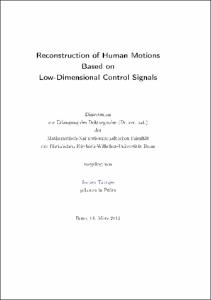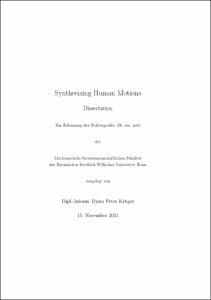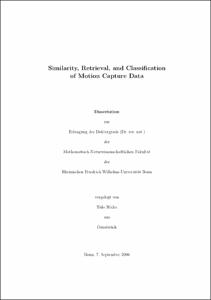Reconstruction of Human Motions Based on Low-Dimensional Control Signals

Reconstruction of Human Motions Based on Low-Dimensional Control Signals

| dc.contributor.advisor | Weber, Andreas | |
| dc.contributor.author | Tautges, Jochen | |
| dc.date.accessioned | 2020-04-18T00:38:18Z | |
| dc.date.available | 2020-04-18T00:38:18Z | |
| dc.date.issued | 09.08.2012 | |
| dc.identifier.uri | https://hdl.handle.net/20.500.11811/5362 | |
| dc.description.abstract | This thesis addresses the question to what extent it is possible to reconstruct human full-body motions from very sparse control signals. To this end, we first investigate the use of multi-linear representations of human motions. We show that multi-linear motion models together with knowledge from prerecorded motion capture databases can be used to realize a basic motion reconstruction framework that relies on very sparse inertial sensor input only. However, due to the need for a semantic pre-classification of the motion to be reconstructed and rather restricting database requirements, the described framework is not suitable for a more general motion capture scenario. We address these issues in a second, more flexible approach, which relies on sparse accelerometer readings only. Specifically, we employ four 3D accelerometers that are attached to the extremities of a human actor to learn a series of local models of human poses at runtime. The main challenge in generating these local models is to find a reliable mapping from the lowdimensional space of accelerations to the high-dimensional space of human poses or motions. We describe a novel online framework that successfully deals with this challenge. In particular, we introduce a novel method for very efficiently retrieving poses and motion segments from a large motion capture database based on a continuous stream of accelerometer readings, as well as a novel prior model that minimizes reconstruction ambiguities while simultaneously accounting for temporal and spatial variations. Thirdly, we will outline a conceptually very simple yet very effective framework for reconstructing motions based on sparse sets of marker positions. Here, the sparsity of the control signal results from problems that occurred during a motion capture session and is thus unintentional. As a consequence, we do not control the information we can access, which introduces several new challenges. The basic idea of the presented framework is to approximate the original performance by rearranging suitable, time-warped motion subsequences retrieved from a knowledge base containing motion capture data that is known to be similar to the original performance. | en |
| dc.language.iso | eng | |
| dc.rights | In Copyright | |
| dc.rights.uri | http://rightsstatements.org/vocab/InC/1.0/ | |
| dc.subject | Computeranimation | |
| dc.subject | Bewegungserfassung | |
| dc.subject | Bewegungsrekonstruktion | |
| dc.subject | Bewegungssynthese | |
| dc.subject | Beschleunigungssensoren | |
| dc.subject | Inertialsensoren | |
| dc.subject | Multilineares Modell | |
| dc.subject | Tensoren | |
| dc.subject | computer animation | |
| dc.subject | motion capture | |
| dc.subject | motion synthesis | |
| dc.subject | motion reconstruction | |
| dc.subject | motion retrieval | |
| dc.subject | accelerometers | |
| dc.subject | inertial sensors | |
| dc.subject | multi-linear model | |
| dc.subject | tensors | |
| dc.subject | online lazy neighborhood graph | |
| dc.subject | subsequence graph | |
| dc.subject | dynamic time warping | |
| dc.subject.ddc | 004 Informatik | |
| dc.title | Reconstruction of Human Motions Based on Low-Dimensional Control Signals | |
| dc.type | Dissertation oder Habilitation | |
| dc.publisher.name | Universitäts- und Landesbibliothek Bonn | |
| dc.publisher.location | Bonn | |
| dc.rights.accessRights | openAccess | |
| dc.identifier.urn | https://nbn-resolving.org/urn:nbn:de:hbz:5n-29462 | |
| ulbbn.pubtype | Erstveröffentlichung | |
| ulbbnediss.affiliation.name | Rheinische Friedrich-Wilhelms-Universität Bonn | |
| ulbbnediss.affiliation.location | Bonn | |
| ulbbnediss.thesis.level | Dissertation | |
| ulbbnediss.dissID | 2946 | |
| ulbbnediss.date.accepted | 27.07.2012 | |
| ulbbnediss.fakultaet | Mathematisch-Naturwissenschaftliche Fakultät | |
| dc.contributor.coReferee | Badler, Norman I. |
Files in this item
This item appears in the following Collection(s)
-
E-Dissertationen (4400)







